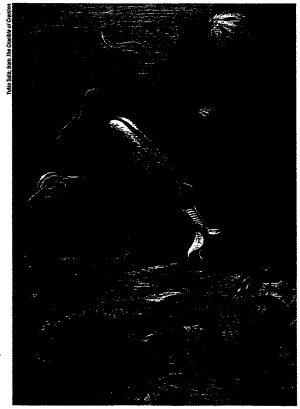| 49 |
Evolution | Natural History 12/98 -1/99 |
(THE CHALLENGE, continued
from page 48)
tion of patterns in the fossil record, then move on to paleontological
particulars, and finally offer different "lessons" on what the Burgess
Shale means in the larger reading, of evolutionary history.
GOULD
HINTS AT A SPECIAL
MECHANISM AT WORK IN THE BURGESS
FAUNA--A GENETIC
HAPPENSTANCE
GONE WILD. |
 |
Gould
emphasizes, above all, the apparent weirdness and diversity of the Burgess fossils.
How, he asks, was such an extraordinary range of anatomies produced, and all apparently
in a blink of geological time? He hints at a special mechanism at work--some
unusual genetic happenstance gone wild--that might account for the production
of so many biological novelties in such a startlingly short period of time, perhaps
only a few million years. And what if we could "rerun the tape" so that
the subsequent history of this maelstrom of diversification would have taken a
different course? We would still have a planet full of life, he argues, but surely
one utterly different from our familiar world. Notably, this new trajectory of
evolution would probably not have led to the human species and its unique form
of consciousness and self-awareness, which emerged through a series of contingent
accidents in a unique, unrepeatable sequence.Gould also charges that
Charles D. Walcott, the discoverer of the Burgess Shale, was ill equipped to appreciate
how diverse these novel phyla of sea creatures really were. Committed to the orthodox
view that the range of life-forms must become ever greater over time, Walcott,
in Gould's view, was unprepared to confront a world in which the proliferation
of different kinds of life-forms (phyla) was much greater in the distant Past
than in, say, the age of dinosaurs or the more recent age of mammals. Therefore,
he argues, Walcott attempted to "shoehorn" a range of previously unknown
creatures into a few familiar categories to fit his preconceptions. Gould' asserts
that paleontologists have only just begun to-appreciate the ever-expanding catalog,
of bizarre "dead-end experiments" conducted by nature in ancient seas.Looking,
back at the Cambridge group's classifications of the Burgess Shale, undertaken
many decades after Walcott's pioneering work, my colleagues and I can see that
we made some mistakes. Too often, we thought we had stumbled across yet another
novel body plan (phylum, if you will), and in a few crucial instances, we did
not realize that seemingly unrelated fossils were actually fragments of a single
organism. With the benefit of hindsight, we can see that we had exaggerated the
diversity of these supposedly bizarre fossils and needed to reconsider their evolutionary
relationships. Recent discoveries in southern China (Yunnan) and northern Greenland
(Peary Land) have provided links that join several of these previously unconnected
fossils and establish them in recognizable phyla.
Let's begin with
the animal Wiwaxia. In Wonderful Life, it is described as "another
Burgess oddball, perhaps closer to the Mollusca than to any other modern phylum
... but probably not very close." Ironically, the first breakthrough in establishing
Wiwaxia's affinities came from a postgraduate paleontologist at Harvard
who was inspired by Gould's lectures a decade or so ago. This young researcher,
Nick Butterfield, managed to extract pieces of scalelike armor from the fossilized
creature. When Butterfield studied their microstructure, he noticed immediately
that it was the same as that of the chitinous bristles (chaetae) that project
from the bodies of such modern annelids as earthworms. His conclusion, published
in 1990, was that Wiwaxia was not a mollusk at all but an annelid. Yet
this was what Walcott had claimed in 1911. In at least this case, Butterfield
concluded, Walcott was not "shoehorning" bizarre animals into familiar |